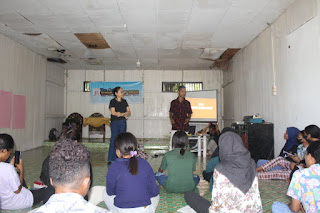By: Salsa Bila Sogo, S.Mat.
Sexual and reproductive health issues are still new to the trainees, and even they are not familiar with Sexual and Reproductive Health Rights (SRHR). In general, sexual and reproductive issues are still considered taboo and even considered unimportant, although learning about these issues is very important to know self-understanding, to know whether the health rights have been fulfilled, to encourage how to express sexuality in a responsible and healthy way, and to know the accurate and scientific principles. The understanding of SRHR is given in stages according to the child's growth and the principle of gender equality.
In this session, Mariana Yunita Opat explained SRHR and the 12 reproductive rights formulated by the International Planned Parenthood Federation (IPPF) in 1996, including the right to life, the right for freedom and security, the right for equality and freedom from all forms of discrimination, the right of privacy, the right for freedom of thought, the right to have information and education, the right to marry and not marry as well as to form and to plan a family, the right to decide to have children or not and the time to have children, the right to get health care and protection, the right to get benefit from scientific advances, the right for freedom of assembly and participation in politics, and finally the right to be free from persecution and ill-treatment.
Why do we need to know and understand SRHR? This sexuality education provided knowledge, skills, and values to grow up happy and healthy for the participants. They will be aware of health and welfare and build social and sexual relationships that are equal, dignified, and respectful of each other by considering their own and others’ choices. Furthermore, they can protect each other, fight for and defend themselves and others' sexual and reproductive rights from various acts of violence and offense. The resource person also explained several legal instruments related to SRHR.
Regarding the material on sexual violence, Mariana explained the definition of sexual violence, that is, any actions to demean, insult, attack, or other actions against the body related to sexual desire, and or reproductive function by force. Cases of violence against women throughout 2020 reached 299.911 cases (CATU 2020 Komnas Perempuan), while cases of sexual violence against children occurred during 2021 (data from the Ministry of Women's Empowerment and Child Protection) reached 6.547 cases. The results of the KRPA survey of sexual violence show the highest are on public streets, social media, residential areas, chat applications, public transportation, online dating applications, shopping center, virtual games, workplaces, and virtual discussion rooms.
She
explained 15 forms of sexual violence according to Komnas Perempuan, such as
sexual harassment, forced marriage, for example in Sumba such as ‘marriage
arrest’, sexual control, sexual exploitation, forced abortion, sexual slavery,
forced prostitution, forced contraception, sexual intimidation, traditional
practices, sexual torture, forced pregnancy, rape, trafficking in women, sexual
punishment. Gender and sexuality-based violence occur because of imbalance power
relations.
In
this session, Therlince Loisa Mau, the facilitator of the Disaster Resilient
Church in Alor shared her experiences with disaster mitigation, such as
violence against women and children, earthquakes, Covid, and floods. The
participants discussed the problems and find solutions or ways to solve them.
The activity ended with the hope that the participants will be equipped and
correct to apply it in their life. ***
.png)




.jpg)

Comments
Post a Comment